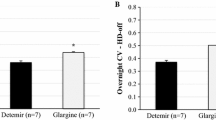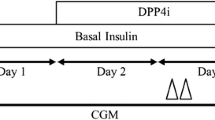Summary
Based on the known action of xanthine derivatives on the insulin secretion, the effect of pentoxifylline on carbohydrate homeostasis of type I (IDDM) and type II (NIDDM) diabetics was investigated. Pentoxifylline is known to exert a favorable influence on hemorheological disturbances in such patients. Twenty-four hour blood glucose pattern and insulin requirements were evaluated in type I and type II diabetics by the use of the artificial pancreas before and after a 14-day treatment with pentoxifylline 400 mg p.o. (Trental 400®) t.i.d. During the stabilization period before treatment with pentoxifylline, NIDDM patients required 10.1±3.8 U of insulin and the IDDM 35±13.7 U. After 2 weeks on pentoxifylline, NIDDM required only 6.3±2.8 U (p<0.05) and IDDM 28.5±9.7 U (n.s.). Average blood glucose during the 24h decreased by 15.8±3.5% in NIDDM and by 10.3±2.5% in IDDM. Moreover, a significant smoothing of glucose fluctuations during the 24h was noted in both groups. It is concluded that pentoxifylline administered concurrently to any antidiabetic type of treatment leads to better blood glucose control as well as to prevention or delay of vascular complications.
Similar content being viewed by others
References
Aikawa J. K.: Factors influencing the tissue uptake of magnesium in biologic processes. In:Aikawa J. K. (Ed.): Ch. C. Thomas, Springfield/IL, 1963.
Angelkort B., Kiesewetter H.: Influence of risk factors and coagulation phenomena on the fluidity of blood in chronic arterial occlusive disease—Scand. J. clin. Lab. Invest.41 (Suppl. 156), 185, 1981.
Angelkort B., Spürk P., Habbaba A., Mähder M.: Blood flow properties and walking performance in chronic arterial occlusive disease—Angiology36, 285, 1985.
Barnes A. J., Locke P., Scudder P. R., Dormandy T. L., Dormandy J. A., Slack J.: Is hyperviscosity a treatable component of diabetic microcirculation disease?—Lancetii, 789, 1977.
Basabe J. C., Udrisar D. P., Knopf C. F., Aparicio N.: The influence of pentoxifylline [1-(5-oxohexyl)-3,7-dimethylxanthine] (BL 191) on the insulin secretion induced by glibenclamide and by arginine/glucose in the perfused pancreas—Acta diabetol. lat.14, 263, 1977.
Blagosklonnaya Ya. V., Mamedov R., Kozlov V. V., Emanuel V. L., Judryashova M. I.: Einfluss von Trental auf die Nierenfunktion bei Patienten mit Diabetes mellitus—Probl. Endokrinol. (Moskva)28, 3, 1982.
Brancato R., Menchini U., Michelone C.: Evaluation of the action of pentoxifylline on the conjunctival microcirculation in diabetics—Pharmaceutica3 (Suppl. 1), 42, 1983.
Burr I. M., Balant L., Stauffacher W., Renold A. E.: Perfusion of rat pancreatic tissuein vitro: substrate modification of theophylline-induced biphasic insulin release—J. clin. Invest.49, 2097, 1970.
Burr I. M., Stauffacher W., Balant L., Renold A. E., Grodsky G. M.: Regulation of insulin release in perfused pancreatic tissue. In:Loubatières A., Renold A. E. (Eds): Pharmacokinetics and mode of action of oral hypoglycemic agents. Casa Editrice Il Ponte, Milano, 1969; Acta diabetol. lat.6 (Suppl. 1),580, 1969.
Butcher R. W., Sutherland E. W.: Adenosine-3′,5′-phosphate in biological materials. I. Purification and properties of cyclic 3′,5′-nucleotide phosphodiesterase and use of this enzyme to characterize adenosine-3′,5′-phosphate in human urine—J. biol. Chem.237, 1244, 1962.
Cerasi E., Luft R.: The effect of an adenosine-3′,5′-monophosphate diesterase inhibitor (aminophylline) on the insulin response to glucose infusion in prediabetic and diabetic subjects—Hormone metabol. Res.1, 162, 1969.
Cerasi E., Luft R.: The effect of theophylline on the insulin response to glucose infusion in prediabetic and diabetic subjects—Diabetologia6, 39, 1970.
Conte N., Federspil G., Frezzato S., Trisotto A., Scandellari C., Piemonte G.: Glucagon effect on plasma Mg concentration—Hormone metabol. Res.4, 48, 1972.
Deyhle P., Miederer S. E., Stadelmann O.: Der Einfluss von Secretion auf die durch Methylxanthine (Theophyllin) stimulierte Säure-, Elektrolyt- und Pepsinogensekretion des menschlichen Magens—Klin. Wschr.49, 1231, 1971.
Elben U., Schröer R.: Calcium complexes of xanthine derivatives: a new aspect of the mode of action of haemorheologically active drugs—Arzneimittel-Forsch.34, 3, 253, 1984.
Ensinck J. W., Stoll R. W., Gale C. C., Santen R. K., Toubery J. L., Williams R. H.: Effect of aminophylline on the secretion of insulin, glucagon, luteinizing hormone and growth hormone in humans—J. clin. Endocrinol.31, 153, 1970.
Grigoleit H.-G., Lehrach F.: Blutviskosität und Diabetes mellitus—Med. Mschr.27 (Suppl. 8), 353, 1973.
Grigoleit H.-G., Lehrach F., Müller R.: Diabetic angiopathy and blood viscosity—Acta diabetol. lat.10, 1311, 1973.
Heidrich H., Schirop Th.: Blood glucose and serum insulin levels following acute and chronic pentoxifylline administration—Acta diabetol. lat.17, 15, 1980.
Heidrich H., Schirop Th., Fichte K.: Einfluss gefässaktiver Pharmaka auf den Blutzucker und das Seruminsulin—Med. Klin.72, 94, 1977.
Heilmann E., Zimmermann B., Gruss P.: Effect of pentoxifylline in hypercoagulability in patients with polycythemia vera—IRCS med. Sci.10, 594, 1982.
Hess H., Franke I., Jauch M.: Medikamentöse Verbesserung der Fließeigenschaften des Blutes. Ein wirksames Prinzip zur Behandlung von arteriellen Durchblutungsstörungen— Fortschr. Med.91, 743, 1973.
James D. R., Holland B. M., Hughes M. R., Jones J. G., Wardrop C. A. J.: Oxpentifylline effects on red cell deformability and oxygen availability from the blood in intermittent claudication—Clin. Hemorheol.4, 525, 1984.
Königstein R. P.: Klinische Erfahrungen mit Pentoxifyllin aus der Sicht des Diabetologen. Der praktische Arzt. Kongressband Pentoxifyllin Colloquium, Wien, 1975; p. 47–52.
Lambert A. E., Jeanrenaud B., Renold A. E.: Enhancement by caffeine of glucagon-induced and tolbutamide-induced insulin release from isolated fetal pancreatic tissue—Lanceti, 819, 1967.
Lambert A. E., Kanazawa Y., Halter J. B., Orci L., Rouiller C., Renold A. E.: Insulin release from fetal and newborn rat pancreasin vitro: Role of the adenylcyclase system. In:Luft R., Randle P. J. (Eds): On the pathogenesis of diabetes mellitus. Casa Editrice Il Ponte, Milano, 1970; Acta diabetol. lat.2, 229, 1970.
Larvor P., Durlach J.: Relations entre magnesium et glandes endocrines. In:Durlach J. (Ed.): First International Symposium on Magnesium Deficit in Human Pathology. J. Vittel, 1971.
Lenti G., Pagano G., Angotzi G., Basetti Sani A., Diana A.: Effects of a xanthine derivative (BL 191) on insulin secretion in normal man—Europ. J. clin. Pharmacol.9, 189, 1975.
Lossnitzer K., Raptis S., Grebe B., Müller R.: The influence of 3,7-dimethyl-1-(5-oxohexyl)-xanthine (pentoxifylline, BL 191) on serum calcium and magnesium levels—Arzneimittel-Forsch.23, 938, 1973.
Malaisse W., Malaisse-Lagae F.: A possible role for calcium in the stimulus-secretion coupling for glucose-induced insulin secretion. In:Luft R., Randle P. J. (Eds): On the pathogenesis of diabetes mellitus. Casa Editrice Il Ponte, Milano, 1970; Acta diabetol. lat.7 (Suppl. 1), 264, 1970.
Malaisse W. J., Malaisse-Lagae F., Mayhew D.: A possible role for the adenylcyclase system in insulin secretion—J. clin. Invest.46, 1724, 1967.
Masowezkij A. G., Stoilov L. D., Kukaschina T. V., Tirkina T. N., Titova S. I.: The use of pentoxifylline in diabetes mellitus—Pharmatherapeutica2 (Suppl. 1), 105, 1978.
Milner R. D. G., Hales C. N.: The role of calcium and magnesium in insulin secretion from rabbit pancreas studiedin vitro—Diabetologia3, 47, 1968.
Milner R. D. G., Hales C. N.: Cations and the secretion of insulin—Biochim. biophys. Acta (Amst.)150, 165, 1968.
Müller R.: Pentoxifylline—A biomedical profile—J. Med.5, 307, 1979.
Müller R.: On the therapy of disturbances of blood fluidity—Angiology36, 226, 1985.
Ott E., Lechner H., Fazekas F.: Hemorheological effects of pentoxifylline on disturbed flow behaviour in patients with cerebrovascular insufficiency—Europ. Neurol.22 (Suppl. 1), 105, 1983.
Perego M. A., Sergio G., Artale F., Giunti P., Danese G.: Haemorheological improvement by pentoxifylline in patients with peripheral arterial occlusive disease—Curr. med. Res. Opin.10, 135, 1986.
Petruzzi E., Bucalossi A., Corri S., Marsili A., DiNoto C.: L'uso della pentossifillina nei diabetici con claudicatio intermittens—La Ricerca Clin. Lab.13(Suppl. 3), 451, 1983.
Pfeiffer E., Beischer W., Kerner W.: The artificial endocrine pancreas in clinical research. In:Kruse-Jarres J. D., Molnar G. D. (Eds): Blood glucose monitoring. Methodology and clinical application of continuousin vivo glucose analysis. Georg Thieme Publishers, Stuttgart, 1977; Hormone metabol. Res. (Suppl. 7), 95, 1977.
Pfeiffer E., Thum Ch., Clemens A.: The artificial beta cell. A continuous control of blood sugar by external regulation of insulin infusion (glucose controlled insulin infusion system)— Hormone metabol. Res.6, 339, 1974.
Pfeiffer E., Thum Ch.,Raptis S., Beischer W., Ziegler R.: Hypoglycemia in diabetics. In:Andreani D., Lefèbvre P., Marks V. (Eds): Hypoglycemia. Georg Thieme Publishers, Stuttgart, 1976; Hormone metabol. Res. (Suppl. 6), 112, 1976.
Popendiker K., Boksay I., Bollmann V.: Zur Pharmakologie des neuen peripheren Gefässdilatators 3,7-Dimethyl-1-(5-oxohexyl)-xanthin—Arzneimittel-Forsch.21, 1160, 1971.
Raptis S.: Gastrointestinale Hormone und Insulin-und Glukagonsekretion des menschlichen Pankreas. In:Raptis S.: Enterohormone und endokrines Pankreas. Georg Thieme Verlag, 1974; p. 33.
Raptis S., Escobar-Jimenez F., Maier V., Müller R., Rosenthal J.: Somatostatin and pentoxifylline modulation of insulin, glucagon and growth hormone following stimulation of arginine—Acta endocrinol. (Kbh.) (Suppl. 208), 51, 1977
Raptis S., Escobar-Jimenez F., Schlegel W., Müller R., Schröder K. E.: The influence of somatostatin on the arginine and pentoxifylline-induced insulin, glucagon and growth hormone secretion—Diabetologia12, 415, 1976; abstract #221.
Raptis S., Karaiskos K., Enzmann F., Hadjidakis D., Zoupas Ch., Souvatzoglou A., Diamantopoulos E., Moulopoulos S.: Biologic activities of biosynthetic human insulin in healthy volunteers and insulin-dependent diabetic patients monitored by the artificial endocrine pancreas—Diabetes Care4, 155, 1981.
Raptis S., Pfeiffer E. F.: Progress in oral therapy of diabetes mellitus with sulphonylureas of the second generation—Acta diabetol. lat.9, 965, 1972.
Schatz H., Hinz M., Maier V., Nierle C., Pfeiffer E. F.: Cyclic AMP and gastrointestinal hormones. Studies in isolated pancreatic islets—Acta endocrinol. (Kbh.) (Suppl. 173), 1973; Abstract #125.
Schmid-Schönbein H., Volger E.: Red-cell aggregation and red-cell deformability in diabetes— Diabetes25 (Suppl. 2), 897, 1976.
Schubotz R.: Double blind trial of pentoxifylline in diabetics with peripheral vascular disorders—Pharmatherapeutica1, 172–179, 1976.
Seiffge D., Kiesewetter H.: Effect of pentoxifylline on single red cell deformability—Klin. Wschr.59, 1271, 1981.
Serrano-Ríos M., Hawkins F. G., Escobar-Jimenez F., Rodriguez-Minon J. L.: The effect of aminophylline on insulin release induced by secretin and cholecystokinin-pancreozymin in normal humans—J. clin. Endocrinol.38, 194, 1974.
Solerte S. B., Ferrari E.: Diabetic retinal vascular complications and erythrocyte filterability: results of a 2-year follow-up study with pentoxifylline—Pharmaceutica4, 341, 1985.
Strano A., Davì G., Avellone G., Novo S., Pinto A.: Double-blind cross-over study of the clinical efficacy and the haemorheological effects of pentoxifylline in patients with occlusive arterial disease of the lower limbs—Angiology35, 439, 1984.
Sudgen M. C., Aschroft S. J. H.: Effect of phosphoenolpyruvate, other glycolytic intermediates and methylxathines on calcium uptake by a mitochondrial fraction from rat pancreatic islets—Diabetologia15, 173, 1978.
Sutherland E. W., Butcher R. W., Robinson G. A., Hardman J. G.: The role of adenosine 3′,5′-monophosphate in hormone action. In:Karlson P. (Ed.): Wirkungsmechanismen der Hormone. Springer Verlag, Berlin, 1967; p. 1.
Sutherland E. W.: The role of cyclic AMP in the control of carbohydrate metabolism— Diabetes18, 197, 1969.
Thompson J. C., Reeder D. D., Buchman H. H., Becker H. D., Brandt E. M.: Effect of secretin on circulating gastrin—Ann. Surg.176, 384, 1972.
Turtle J. R., Littleton G. K., Kipnis D. M.: Stimulation of insulin secretion by theophylline— Nature (Lond.)213, 727, 1969.
Volger E.: Hämorheologische Befunde beim Diabetes und ihre klinische Relevanz—Wien. med. Wschr.136 (Sonderheft), 5, 1986.
Wilcoxon F.: Individual comparisons by ranking methods—Biometrics1, 80, 1945.
Author information
Authors and Affiliations
Additional information
Dedicated to Prof. Dr. med. h.c. Ernst F. Pfeiffer on the occasion of his 65th birthday anniversary.
This work was supported by grants from the Social Ministry, Athens, Greece; Department of Internal Medicine I, University of Ulm, FRG;Deutsche Forschungsgemeinschaft SFB87 Endokrinologie, Ulm, FRG; the Alexander Onassis Foundation, Vaduz, Liechtenstein.
Rights and permissions
About this article
Cite this article
Raptis, S., Mitrakou, A., Hadjidakis, D. et al. 24-h blood glucose pattern in type I and type II diabetics after oral treatment with pentoxifylline as assessed by artificial endocrine pancreas. Acta diabet. lat 24, 181–192 (1987). https://doi.org/10.1007/BF02732036
Received:
Issue Date:
DOI: https://doi.org/10.1007/BF02732036




